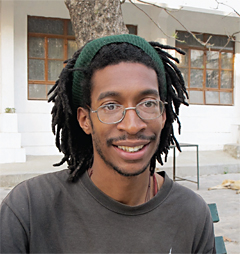
Profession: student
Age: 32
Location: Dharamsala, India
Where are you from? New York, but I grew up in Panama.
How did you get into Buddhism? When I was in college in Kentucky I met some Tibetan exchange students. We got to be friends, and I started helping out with their Free Tibet stuff. We went on a peace march from Bloomington to Indianapolis. One friend took me to a Manjushri initiation with the Sakya Trizin. I was like, who is this Native American dude sitting on the throne? I sat my ass down and was like, “Right on.” I was an utter neophyte. I just went along with it, throwing rice, doing funky signs. I took refuge unknowingly; it wasn’t until I came to India that I took refuge [with H.H. the Sakya Trizin] for real.
What did you decide to study Tibetan? When I first started reading about Buddhism I thought, If I want to be good at this stuff I need to know what’s going on. I have to read it in its original language, not just taking it because someone said so—I wanted to know how everything was fitting together. I mean, Buddha even said, Don’t take my word for it. If you agree, you agree; if you don’t, you have to understand your reasons why you don’t. So that’s why I started studying Tibetan.
Vegetarian? No. I was until I came to India, and then the Tibetans challenged my vegetarianism.
What’s your favorite Buddhist book? I studied Nagarjuna’s Letter to a Friend, and I really enjoyed that. I also like Shantideva’s Way of the Bodhisattva.
What are you doing now? I just started the dialectic program, studying philosophy here at Sarah [The College for Higher Tibetan Studies at Sarah, near Dharamsala]; it’s an institute of Buddhist dialectics. Today was my third day back, actually. I’ll be learning traditional debate, the whole nine yards. From 8 to 9:30 a.m. we debate, then 10:30 to noon we have class, then lunch and mandatory study period, then prayers, and then a night debate from 7 to 9 p.m.
How long have you been in India? This is my third year at Sarah College, and I’ve been in India for four years.
Are there other lay practitioners in the program? There are four non-monastics out of thirty-eight. There are four nuns, the rest are all monks.
Everyone in the program is fluent in Tibetan? Yes. There are various levels, but all of us are pretty comfortable with Tibetan.
Are you the only black person in the program? I’m the only black person within a hundred-mile radius of this place.
What do the monks think about you? For a lot of them I’m the first black person they’ve ever met. It’s like being a blue person walking down the middle of Manhattan. Indians come out of their houses, bringing the kids and the cameras. I’m cool with it, it’s just curiosity. They are all like, “Obama!” and “Bob Marley!” And I’m like, “Change! Hope!”
What does your family think about you pursuing this path? I think they are absolutely elated. Especially my mother. Before coming to India I was homeless for four years. I ran away from home when I was younger, and I was an utter vagabond, doing not much of anything. So for me to be here doing something like this, they are absolutely elated.
What do you plan to do next? Well, if you do the whole program and become a geshe, it’s sixteen years. There are several different levels you can go through, and at this point I want to go all the way through Madhyamika, which takes twelve years. They also have a Rime studies program that I’m also considering, but I’ll have to see how good I am at this. There is a lot of memorization and reasoning. If I can hold my own after a set amount of time then I’ll do the Rime studies. As a layperson I can’t become a geshe anyway, which is perfectly OK with me. I’d like to be a translator eventually.
How do you think you’ve changed since being here? It’s been a slow process, but I’m paying a lot more attention to awareness and inner development. Being more patient, trying to see things as they are, not always projecting myself on everything. At home we’re indoctrinated to think everything is about you, all the time. That’s a really hard thing to unlearn, but if you don’t, it’s going to be very challenging. I haven’t conquered that kind of stuff at all. But when there’s conflict or inner conflict, it’s easier now for me to identify that this is something I need to work with, and here are the things I can use to work with it. That has been a real treasure to me.
—Noa Jones